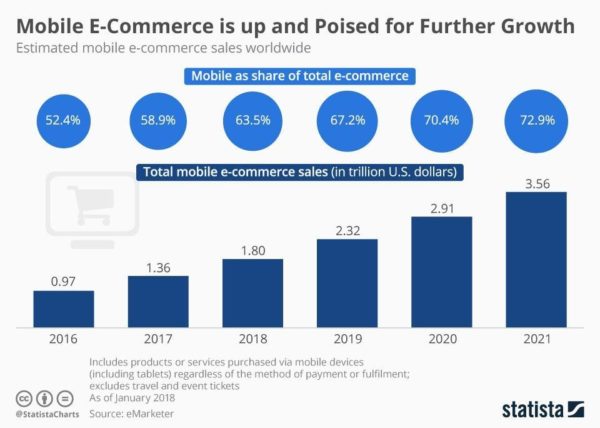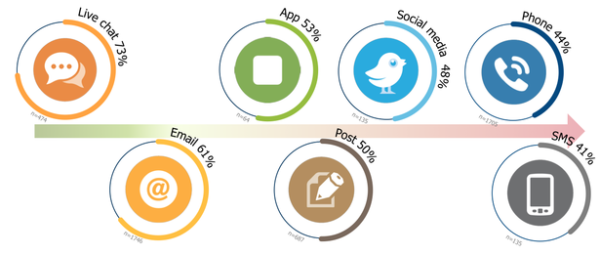
Convincing customers to buy what you’re selling is trickier online than it is with a brick and mortar store. You don’t have a friendly face behind the counter to greet them, or a helpful associate to guide them to what they’re looking for. But that doesn’t mean you have to leave your online retail success to chance.
By using a few basic strategies to improve your online store and streamline customer experiences, you can increase your sales and offer your customers the kind of hands-on support they expect from both online and in-person stores.
These 11 retail marketing strategies can help you learn how to increase sales in retail and stand out from the crowd online.
Get all the tools you need to quickly find new customers and grow your retail store’s sales.
1. Send abandoned cart emails
According to SalesCycle, more than 75 percent of retail website visitors add items to their cart but never complete the checkout process. Abandoned cart emails targeted toward these visitors can help you recover lost sales.
You can use several tactics to reach out to shoppers who left items in their carts. One way is to extend a special one-time offer, like free shipping on orders totaling a specific dollar amount. Another attention-grabbing tactic is to personalize email subject lines by referencing an item the customer left behind.
2. Add videos to product listings
Videos are a great way to build engagement online. This is as true for your social media marketing as it is for your retail strategy. Not convinced? Check out these recent survey results about videos and marketing:
- 62% of retail consumers watch product review videos before making a purchase
- 84% buy a product or service after watching a retailer’s video
- 97% of video marketers reported that video increased user understanding of a product or service
- 56% of consumers believe a company should have video content on its website
Including videos on your product pages can greatly increase your conversion rate, that is, the percentage of visitors who take a desired action, like buying a product or scheduling your services, while visiting your site. Product pages with videos see 37% more add-to-cart conversions than pages without videos.
Compelling video content could include information about the product, a demonstration, or a review. Don’t worry too much about production value. Customers are looking for easy-to-digest information, not entertainment.
Visitors tend to respond better to shorter videos — a common rule of thumb is to aim for one to three minutes.
3. Partner with social network influencers
Influencers are a growing part of the marketing business. In fact, a recent Digital Marketing Institute survey revealed that 86 percent of marketers have used influencer marketing in the past year.
When popular social media influencers endorse products, retailers benefit significantly. Influencer Marketing Hub reports that, on average, businesses are earning about $6.50 for every dollar they spend on influencer marketing. The top 13 percent are bringing in $20 per dollar spent.
Influencer marketing is a good investment, partly because you can repurpose content across other channels, including on product display pages. You can also create and promote a video library section on your site where you compile product videos.
4. Start a blog
Content marketing is essential for online retailers. Quality content adds authority and value to your brand, and it can enable your website to rise through search engine rankings. Most importantly, good content attracts leads and increases conversion rates.
Blog content can be time-consuming to create, but like influencer marketing, you can repurpose the content across other channels. Promote blog posts on Twitter and Facebook and tease them in your email newsletters.
The goal of a retail website blog is to provide value for customers and drive in more leads, not necessarily to push a specific product, though you can use blog posts for product promotions. Aim for a mix of topics.
5. Improve your website responsiveness
Does your site load quickly? If not, make website responsiveness a priority. Marketing consultant Neil Patel reports that 40 percent of people will abandon a website if they have to wait more than three seconds for it to load.
Your site needs to display correctly on mobile devices, too. At this point, mobile shopping beats out desktop shopping. Online shoppers spent 44 percent of the time they devote to online shopping on smartphones and 11 percent on tablets. If your site is clunky or inoperable on mobile devices, you’re likely losing sales daily.

6. Offer free shipping
Online retail customers are four to five times more likely to make a purchase when retailers offer free shipping. Crunch the numbers to figure out the price points that won’t tank revenue and that make the increase in conversions worth the hassle.
7. Use smart pop-ups
Pop-ups are small windows that appear on a web page. They can appear right when you open a page or gradually fade in or slide in from the top, bottom, or side of the page. You’re probably familiar with pop-up ads, but you can also use pop-up windows to encourage visitors to take actions like signing up for a mailing list.
Using pop-ups effectively is more art than science, but when retailers land on the right approach, this technique bears significant results.
Common pop-up strategies include:
- Delayed pop-ups: appear after a set period of time
- Pushdown pop-ups: push page content down the page
- Pushup pop-ups: slide up from below the screen
- Exit-intent pop-ups: appear when a customer attempts to leave the site
- Sign-up forms: invite visitors to subscribe to resources like email promotions
8. Create interactive email content
Email marketing is still one of the most effective ways to reach your audience. The key to this strategy is to create email content that stands out from the rest.
Clickable, interactive emails drive in better results. For example, you could create a quiz to help shoppers make product decisions or discover their own “shopping types.” You can also create interactive email content featuring rewards and incentives, like limited offer discount codes. If you can make your customers feel special with your email communications, they’re more likely to buy.
9. Add a live chat feature to your website
Live chat is the leading digital contact method, well ahead of email and social media. It allows customers to receive immediate responses to product questions, and gives them the personalized guidance they’d get at an in-person store.
When you answer customers’ questions immediately, you can remove many buying objections on the virtual sales floor. Not only does that drive conversions, but it can also significantly improve customer satisfaction, which builds customer loyalty over time.

10. Launch a brand ambassador program
When you turn customers into advocates, or brand ambassadors, you’ll grow organic customer relationships while making more sales. Brand ambassadors are loyal fans of your brand. They’ll share honest feedback about how much they like your product or service through word-of-mouth, social media networks, and other channels.
Develop a core group of brand ambassadors and reward these customers with freebies, service upgrades, and other exclusive benefits. The goal is to create a group of people who feel like valued members of your team and are willing to convince others to try your product or service.
11. Offer “buy now, pay later” services
When you make it simple for customers to buy now and pay later, you convert more leads. Customers are more likely to complete the purchase and less likely to change their minds. These pay later services are much like the in-store layaway plans that were popular among shoppers for decades, and they can make your product accessible to people who wouldn’t otherwise be able to afford it.
At this point, there are many options for pay later partners, including:
If at first you don’t succeed…
Try, try again! These techniques are all affordable, manageable retail marketing strategies no matter your business size or budget. Since no two brands are alike, you may need to experiment a bit to get a feel for which online marketing techniques are the best fit for your brand.
Step up your retail marketing game with our free e-guide, The Download. You can also explore tips on finding out how others view your brand’s online presence or how to leverage SMS marketing in retail.




